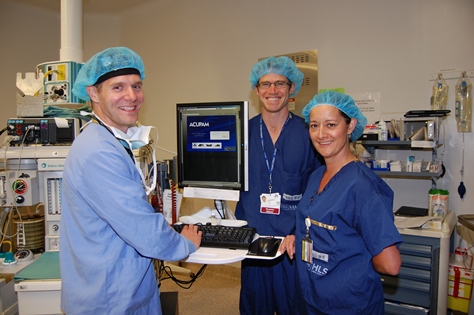
Anesthesiologist Dr. Rejean Gareau (left) monitors the computerized automatic timer that reminds surgical team members, such as Dr. Stephen Kingwell and RN Laurie Crabtree, to give the patient another dose of antibiotics during long surgeries to reduce surgical site infections.
At the 3.5-hour mark during long surgeries, an automatic timer now goes off in the operating room, reminding surgical team members to give the patient another dose of antibiotics within the next half-hour to ward off a surgical site infection.
Over the past year, surgical teams have been working hard to bring down The Ottawa Hospital’s rate of surgical site infections through a number of improvements. Redosing with the antibiotic cefazolin during long surgeries, or in cases where there’s a lot of blood loss, is one of those improvements.
Redosing is now done in about nine out of 10 cases, up from about half of cases in early 2013.
“During a long, stressful case, you’re not always thinking about redosing, so having the timer makes it easier,” said orthopaedic spine surgeon Dr. Stephen Kingwell, who has led his team’s improvements to bring down surgical site infections.
Spinal surgery, trauma cases with multiple injuries and many cancer cases can take longer than four hours. Typically, patients receive a dose of antibiotics just before surgery, but the best practice is to give another dose before the four-hour mark to keep the antibiotic levels up.
“We’ve seen significant improvements in antibiotic delivery because of everyone’s coordinated efforts,” said Rosemary Zvonar, Antimicrobial Pharmacy Specialist, who has worked with Dr. Kathryn Suh to develop antibiotic guidelines.
A surgical site infection can prolong a patient’s hospital stay and often means more surgery and treatment. So this recent success is good news for patient safety.
The success came in stages. First, manual timers were used and entire surgical teams were instructed on how important the redosing was to reducing infections. Then, this past summer, the automatic timers were introduced into operating rooms at the three campuses.
“Informal feedback indicated that manual timers weren’t being used consistently,” said Dr. Steven Papp, surgeon. “Using an automatic electronic timer ensures that a reminder is given and forces a decision about redosing to occur in every case.”
“This innovative use of technology and data enhances our clinicians’ ability to provide our patients with the best care,” said Caitlin Crooks, Information Services Project Manager, who worked with the surgical teams to develop coding for the automatic timers.
All the surgical teams will be watching to see the effects of redosing on the infection rate.

Support patient care and research at
The Ottawa Hospital


 To reset, hold the Ctrl key, then press 0.
To reset, hold the Ctrl key, then press 0.
Comment on this post